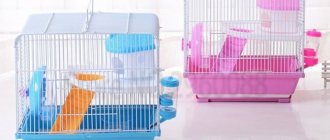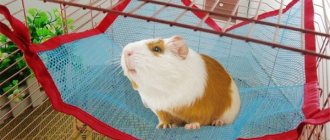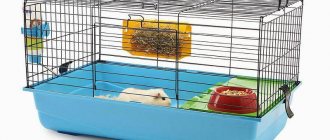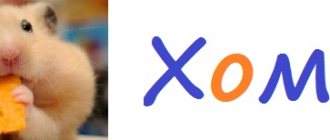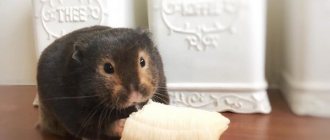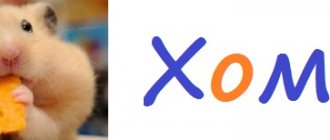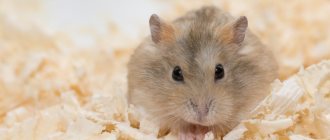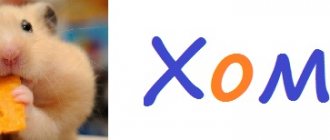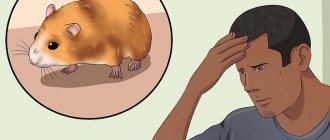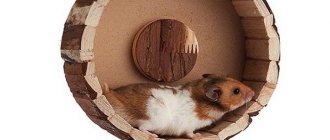A paper hamster folded using the origami technique fully corresponds to the concept of “kawaii” that is fashionable today. The term was introduced into global culture by the Japanese, who first used it in the 1960s to describe adorable children's animal toys. Hamsters, according to the inhabitants of the Land of the Rising Sun, are super-kawaii, that is, “pretty,” “tiny,” “causing a desire to protect and snuggle.” In 2022, Japan was hit by a rodent craze known as Hamuketsu. Fans take pictures of... hamster tails and post them on social networks or send them to each other for admiration. Such pictures are considered an effective anti-stress. Probably, three-dimensional hamster figurines, also made with love, will have an even stronger positive impact.
Origami hamster
A paper hamster folded using the origami technique fully corresponds to the concept of “kawaii” that is fashionable today. The term was introduced into global culture by the Japanese, who first used it in the 1960s to describe adorable children's animal toys. Hamsters, according to the inhabitants of the Land of the Rising Sun, are super-kawaii, that is, “pretty,” “tiny,” “causing a desire to protect and snuggle.” In 2022, Japan was hit by a rodent craze known as Hamuketsu. Fans take pictures of... hamster tails and post them on social networks or send them to each other for admiration. Such pictures are considered an effective anti-stress. Probably, three-dimensional hamster figurines, also made with love, will have an even stronger positive impact.
Friendly family
In nature, hamsters are not particularly favorable towards their fellow creatures and fiercely defend their territory from “strangers” of their species. Pets are less aggressive; for example, dwarfs often live in large families if the cage is spacious and the conditions are favorable. But if real hamsters’ peaceful mood can change at any moment, paper animals will definitely not start fights. You can make a gift for a large family, because among the Chinese and Japanese, for example, small rodents symbolize home comfort and tranquility in family affairs.
For one hamster you will need a square of 15x15 cm or 10x10 cm.
Step-by-step instruction:
- We start from the underside of the sheet. Combine the far right point with the left one. We outline the diagonal. We open the product.
- Raise the lowest point to the top.
- It turns out to be a triangle.
- Bend the top of the first layer down about ¼.
- Turn the workpiece over to the reverse side.
- We fold the lower corners - right and left, as shown in the diagram.
- We bend the side triangular flaps in half.
- We make a “valley” fold along the central axis.
- Rotate the figure 90° clockwise. On the left side we bend the upper corner, on the right side we lift the triangular valve indicated by the arrow.
- We cut it in the center with scissors - we get “ears”.
- Using a “reverse fold,” we bring the corner on the left inside the figure and bring it out, making a “zigzag.”
- We also turn out the tip of the “nose”, repeating the same steps as for the “tail”, only without the zigzag.
Having mastered this model, you can try to build a more complex and realistic one using a detailed video tutorial:
Hamster with a tail
Prepare a square sheet of paper.
Instructions:
- Fold the square diagonally in both directions.
- Fold the corners towards the center in a basic pancake shape.
- Bend opposite corners towards the center.
- Holding the middle of the workpiece, bend the top and bottom of the right side towards the center axis.
- Fold the left corner towards the center on the reverse side.
- Fold the opposite parts of the left side towards the center line.
- Bend the workpiece lengthwise in half with a valley.
- Make an incision and lift the hamster's ears.
- Lower the left corner with a reverse fold.
- Fold the tail in a zigzag pattern.
- All that remains is to draw the eyes.
Another interesting model:
Very simple model for children
Starting from 6–7 years old, a child is able to independently master simple origami models. And one of the first things he will definitely want to do is a hamster, because it is a popular pet. To realize your creative idea, you will need a 10x10 cm square, colored pencils or watercolors and a marker.
Step-by-step instruction:
- Fold the square from top to bottom.
- Divide the resulting rectangle into three parts. Bend it 2/3 way.
- Fold the lower left corner along the dotted line.
- Using the reverse fold, we bring it inward.
- Rotate the lower right corner.
- We do the same with the left one.
- We form another reverse fold at the top right.
All that remains is to draw colored spots with paint, and also use a marker to draw the hamster’s face.
Not a toy, but a family member
It must be remembered that a pet is not a thing that belongs to a child, but a member of the family. The child is like an older brother or sister to him. When we call animals our “little brothers,” these are not empty words. According to the observations of animal psychologists, animals living with people literally “humanize”, acquiring psychological traits that are not inherent to them by nature. Therefore, a humane attitude towards pets is required. Here, adults should also set an example for children, demonstrating exactly this attitude. So, if there is a baby in the house, it is unacceptable to think that the animal should endure everything from him - even if the animal itself (often a big, smart dog) meekly endures blows, pulling by the ears and pulling of the tail. It is necessary to gently but decisively explain to the child that you cannot hurt anyone - neither people nor animals, and if necessary, physically stop him. A one-year-old baby, of course, is not able to understand much, but the expressed displeasure of mom and dad will serve as a signal to him that he is doing something wrong. (This displeasure should be firm, but restrained - so as not to fix the baby’s attention on the “forbidden fruit”, and then it is good to take him away from the temptation, switching his attention to something else.)
The sooner a child learns the need for a humane attitude towards living beings, the better. And for older children, parents can set a good example of responsibility and mercy by refusing to buy an expensive purebred puppy or kitten from breeders and adopting an animal from a shelter.
– I believe that a child should definitely have a pet. He will teach him care and responsibility. Which one exactly is up to you to decide. Better yet, give him as many brothers and sisters as possible! Then he will definitely not grow up to be selfish.
— Valentino Bontempi
Interesting Facts
Hamsters are cautious and secretive animals; they prefer solitude and are especially active at dusk. In nature, they leave their burrows before sunset and return when it gets completely dark. They form pairs only to have offspring. The newborns are nursed by the female, while the “biological father”, having fulfilled his purpose, goes in search of a new passion.
The most popular domestic hamsters are Syrian hamsters; in nature they are on the verge of extinction due to ill-conceived human economic activity. Until 1930, they were considered an extinct species, however, Palestinian zoologist Israel Aharoni managed to discover a female with eleven cubs during a trip to the Middle East. They became the ancestors of all domestic Syrian hamsters.
It is equally interesting to know that:
- The hamster subfamily includes 7 genera, which, in turn, are divided into 19 species. Among them, only 5 are able to adapt to captivity. This is the Campbell and Roborovsky hamster, as well as the Chinese, Djungarian and Syrian.
- In their cheek pouches, the animals carry reserves equal in mass to themselves.
- Translated from German, hamster – hamstern translates as “hoard.” Even rodents born and raised in captivity tend to make large reserves, although they are not in danger of starvation.
- Hamsters have poor eyesight and color blindness, but they have a keen sense of hearing and smell.
- The wheel is an extremely important accessory for a hamster cage. Animals vitally need movement, because in the wild they run up to 12 km per day. The wheel should be plastic, solid, so that the animal’s paws do not get stuck when moving. And tall, otherwise the hamster's back will bend unnaturally, which will lead to arthritis.
- Animals' teeth are constantly growing - they need to be ground down to avoid injury. Special devices for this or, for example, a piece of wood are placed in the hamster house. Rodents often sharpen their teeth on the bars of cages, and owners mistakenly think that this is an attempt to escape.
- Pet hamsters are illegal in Vietnam, Australia, California and Hawaii. Local authorities fear that if the rodents accidentally escape, they will begin to multiply rapidly in the wild. Thereby harming agriculture and the regional biosphere.
Source
In wild nature
Almost all types of hamsters live in steppes and semi-deserts. Water obstacles are very rarely encountered on their path. Therefore, nature did not endow them with the ability to swim well. They do not have webbed feet, like all waterfowl. Fur does not have water-repellent properties and gets wet quickly. Nevertheless, in extreme situations, when you need to escape from an enemy or a fire, or there is a flood, all rodents float quite well on the water. The hamster swims, although poorly and not for long. The fur coat quickly gets wet and becomes too heavy. The rodent may become ill from hypothermia or die from stress.
Wild hamsters are stronger and more aggressive than their domestic relatives. In their natural habitat, they fight for their lives, and only the fittest survive. Decorative animals are more delicate and weaker. They require certain conditions of detention and get sick more often.
So the answer to the question about the buoyancy of hamsters is clear. They know how to swim, but swimming is strictly contraindicated for them.
Crafts for a hamster made of cardboard: master classes with diagrams and sizes
A paper hamster folded using the origami technique fully corresponds to the concept of “kawaii” that is fashionable today. The term was introduced into global culture by the Japanese, who first used it in the 1960s to describe adorable children's animal toys. Hamsters, according to the inhabitants of the Land of the Rising Sun, are super-kawaii, that is, “pretty,” “tiny,” “causing a desire to protect and snuggle.” In 2022, Japan was hit by a rodent craze known as Hamuketsu. Fans take pictures of... hamster tails and post them on social networks or send them to each other for admiration. Such pictures are considered an effective anti-stress. Probably, three-dimensional hamster figurines, also made with love, will have an even stronger positive impact.
Friendly family
In nature, hamsters are not particularly favorable towards their fellow creatures and fiercely defend their territory from “strangers” of their species. Pets are less aggressive; for example, dwarfs often live in large families if the cage is spacious and the conditions are favorable. But if real hamsters’ peaceful mood can change at any moment, paper animals will definitely not start fights. You can make a gift for a large family, because among the Chinese and Japanese, for example, small rodents symbolize home comfort and tranquility in family affairs.
For one hamster you will need a square of 15x15 cm or 10x10 cm.
- We start from the underside of the sheet. Combine the far right point with the left one. We outline the diagonal. We open the product.
- Raise the lowest point to the top.
- It turns out to be a triangle.
- Bend the top of the first layer down about ¼.
- Turn the workpiece over to the reverse side.
- We fold the lower corners - right and left, as shown in the diagram.
- We bend the side triangular flaps in half.
- We make a “valley” fold along the central axis.
- Rotate the figure 90° clockwise. On the left side we bend the upper corner, on the right side we lift the triangular valve indicated by the arrow.
- We cut it in the center with scissors - we get “ears”.
- Using a “reverse fold,” we bring the corner on the left inside the figure and bring it out, making a “zigzag.”
- We also turn out the tip of the “nose”, repeating the same steps as for the “tail”, only without the zigzag.
Having mastered this model, you can try to build a more complex and realistic one using a detailed video tutorial:
Materials for work
At the initial stages, when they become familiar with the technique of how to make origami crafts from paper, they use ordinary materials. For those who are serious about studying this type of art, you will need durable paper that will not spoil the figure with tears. For some products, crinkled paper is suitable. Flower arrangements are made from it.
Everyone knows at least one way to make origami. Young children collect animals; their creativity requires thick colored paper. Origami masters use material specially created for the craft. There is even a unified system of universal signs, using which the process of creating figures is recorded.
When creating complex structures, adhesives are sometimes used. The works are colored with pencils. Using liquid paints can damage the product.
Birds
Easy origami paper crafts are folded from square sheets without using complex techniques. To create a swan, place the paper in front of you. Mark the diagonal without bending it. Fold the top part so that the edge of the side and the corner lie on the diagonal, repeat with the bottom side.
The top and bottom corners lie in the middle of the sheet. Bend them in different directions. Fold the halves diagonally.
A neck is made from the left corner. Raise the top, making a bend. The tip is also bent, creating a head. The right corner is bent in two places, making a curved tail.
- Easy-to-make origami paper crafts for beginners include the figure of a dove with open wings.
A sheet of equal sides is folded diagonally. Place the long side towards you. All corners of the triangle are connected at the top point. The middle and side lines of the resulting figure are marked. They pass through the centers of the side parts, similar to triangles.
Remove the left and right corners of the figure inward and fold it in half. Turn the workpiece over with the long side up.
The side surfaces are raised up. The workpiece is bent so that the tail from the extreme part falls down. Straighten the side surfaces - the wings. Bend their head back.
Box
DIY paper origami crafts have practical applications. Household items are stored in the box. The elegantly decorated product is suitable for gift wrapping. Two sheets are folded into modules.
The paper is folded diagonally, leaving a fold. Turn over and fold again. All corners are connected in the center. Iron the sheet.
The bottom edge is pulled to the middle and folded. Repeat on each side of the workpiece. Unfold the sheet. The contours of the square, the base of the box, are preserved in the center.
The sides are straightened. The top and bottom sides are folded to the center. The right side of the workpiece is brought up, along the preserved contour of the square. Repeat on the other side.
Turn the workpiece with one of the corners down, towards you. Raise the angle up. Fold the corner into the inside of the workpiece. Repeat on the other side. Iron the fold lines. This turns out to be the bottom part of the box.
A lid is made from the second sheet, which is 1 cm larger. Repeat all steps. The box closes tightly.
Cat and mouse
Origami paper crafts for children should be entertaining even after the manufacturing process. Stories and fairy tales are told with the participation of visual characters. Square sheets are used, although other formats are also used in the art of origami.
To fold the mouse, place the paper in front of you at an angle down. Bring the sides to the middle, closing the edges. The lower corners are opened and the part is brought inside.
The upper corner is turned back and the bends are smoothed out. Repeat with the back side. Bend the part in half and open it. The upper corner is rounded, turning it into an animal’s ear. The left acute angle is turned back, forming a tail.
Color the face with pencils or felt-tip pens. Make a shape out of colored paper.
To make a cat, the top corner of the square is brought to the center point. The bottom corner is hidden. Bend the workpiece in half.
The left side is bent so that its edge coincides with the middle of the workpiece. Repeat the steps on the right side. They pick up the lower corners and spread them apart, ironing them.
Turn the workpiece over to the other side. Now you can see the triangle, its tip is lowered down. Draw eyes, paint nose.
Fold the body, connecting the sides of the new sheet in the middle. Bend the part in half. Turn sideways. The lower corner is turned up and to the left. Glue the head.
Hare
According to the origami diagrams, a hare figure is assembled from paper by repeatedly folding and turning the paper inside out.
The square sheet is turned downwards. The side edges are connected to the diagonal. The right and left corners lead to the middle of the part and press.
The inner corners are turned outward, the upper part is brought back, and they are straightened and smoothed. The resulting rhombus in the upper part has the sides folded to the middle. From the bottom of the part, grab the top layer and lift it to the top corner.
Bend the part along the long side, and then fold it in half, like a tick. The right side is bent twice. Turn the part over. The first layer is pulled to the side and down, the tip is hidden inside. Two sharp corners are directed upward, they are straightened to form ears. Draw a dot where the eyes are, the hare is ready.
Fox
To make a forest animal, the paper is first folded diagonally. The instructions are followed step by step:
- Connect the left and right sides.
- The upper and lower sides are led to the middle and connected to form a rhombus.
- The upper half of the diamond is brought back.
- Carefully lift the top layer of paper from the right corner, spreading its ends in different directions.
- Turn the part over so that the left edge touches the table surface.
- Bend the fox's tail and paint its face.
Flowers
The photo of the origami paper craft shows that the buds follow the contours of natural petals. It won’t be difficult for a child to collect such a bouquet for holiday congratulations. Use thick sheets of colored paper.
You will need diagonal folds on the working material. Fold the sheet in half for each bud separately. The side parts are brought inward along the folds. The corners are raised and connected to the top. The sides are bent and the parts are connected in the middle. The center is opened and the flower blooms. All that remains is to connect it to the stem and add leaves.
Photos of paper origami crafts
How to do it yourself?
At home, anyone can make homemade interesting toys for their pet.
Crafts from nuts
You can easily make an interesting toy from walnut shells. For work you need to prepare the following items:
- nuts with whole shell;
- hammer;
- nail;
- rope;
- metal washer.
Let's look at the step-by-step execution of the work.
- Walnuts must be carefully split into two halves, but they must remain whole. You can treat your rodent to the core; such a delicacy will be not only tasty, but also healthy for him.
- Prepare a piece of rope that fits the size of the cage (consider its height). The rope must be strong.
- Using a hammer and nail, make a hole in the center of each shell.
- Tie a washer to the edge of the rope.
- Next, string the peeled nut halves onto it.
- Be sure to leave some room to securely attach the toy to the top bar of the cage.
You can improve this product if you put the animal’s favorite treats in the shell. As you can see, to manufacture the structure you need available materials and very little time.
Sleeve toy
The cardboard rolls left over from kitchen paper towels can be used to create a simple yet fun toy.
Varieties of guinea pig litter
Some owners immediately look for information about the possible harm of such a feature for their pet. Before searching, you should understand that pigs have 2 types of excrement:
- cylinders. This group contains unprocessed food residues; they must be eliminated during the cleaning process;
- in a more liquid substance - it contains vitamins of various groups, which the pig receives during additional digestion of the litter.
Another not very pleasant fact for owners: pigs eat the second type of litter directly from the anus. The fact is that the flora of the animal’s internal organs, in particular the intestines, is not adapted to produce the necessary microelements naturally.
Very simple model for children
Starting from 6–7 years old, a child is able to independently master simple origami models. And one of the first things he will definitely want to do is a hamster, because it is a popular pet. To realize your creative idea, you will need a 10x10 cm square, colored pencils or watercolors and a marker.
- Fold the square from top to bottom.
- Divide the resulting rectangle into three parts. Bend it 2/3 way.
- Fold the lower left corner along the dotted line.
- Using the reverse fold, we bring it inward.
- Rotate the lower right corner.
- We do the same with the left one.
- We form another reverse fold at the top right.
All that remains is to draw colored spots with paint, and also use a marker to draw the hamster’s face.
Whose responsibility?
Article on the topic
Pet for allergy sufferers: which animal to choose? No matter how old the child is, parents must understand that the main responsibility for the pet is always theirs - simply because they are adults. Of course, a child can and should bear an age-appropriate part of the responsibility - this develops him and organizes his life, but in order to learn this, he needs the help of adults. You should not demand a lot from a child at once and expect that he will immediately begin to independently take care of his ward. It may take quite a long time for his parents to remind him of their obligations. It is also necessary to take into account age, remembering that the ability to self-organize in such things does not mature on average until 9–10 years of age. What is really important is to set the child up correctly by explaining to him that purchasing a pet is a serious matter and that the animal will need the care, friendship and loyalty of its owner. (However, do not be angry with the child if he turns out to be indifferent to an animal that he did not choose - then the owner will most likely be the one who made the choice.)
Bulk Djungarian hamster
Using the “Water Bomb” pattern, you can make a three-dimensional origami hamster figurine. The round paper animal is very reminiscent of the “jungarik”. This breed belongs to the miniature variety and is considered the second most popular after the Syrians. Assembling the “Water Bomb”, familiar from childhood, will not be difficult; the only difference from the classic model is that you will need to form the ears and paws of the animal.
And this origami hamster from the famous master Katsuta Kyohei seems just the height of kawaiiness:
Interesting Facts
Hamsters are cautious and secretive animals; they prefer solitude and are especially active at dusk. In nature, they leave their burrows before sunset and return when it gets completely dark. They form pairs only to have offspring. The newborns are nursed by the female, while the “biological father”, having fulfilled his purpose, goes in search of a new passion.
The most popular domestic hamsters are Syrian hamsters; in nature they are on the verge of extinction due to ill-conceived human economic activity. Until 1930, they were considered an extinct species, however, Palestinian zoologist Israel Aharoni managed to discover a female with eleven cubs during a trip to the Middle East. They became the ancestors of all domestic Syrian hamsters.
It is equally interesting to know that:
- The hamster subfamily includes 7 genera, which, in turn, are divided into 19 species. Among them, only 5 are able to adapt to captivity. This is the Campbell and Roborovsky hamster, as well as the Chinese, Djungarian and Syrian.
- In their cheek pouches, the animals carry reserves equal in mass to themselves.
- Translated from German, hamster – hamstern translates as “hoard.” Even rodents born and raised in captivity tend to make large reserves, although they are not in danger of starvation.
- Hamsters have poor eyesight and color blindness, but they have a keen sense of hearing and smell.
- The wheel is an extremely important accessory for a hamster cage. Animals vitally need movement, because in the wild they run up to 12 km per day. The wheel should be plastic, solid, so that the animal’s paws do not get stuck when moving. And tall, otherwise the hamster's back will bend unnaturally, which will lead to arthritis.
- Animals' teeth are constantly growing - they need to be ground down to avoid injury. Special devices for this or, for example, a piece of wood are placed in the hamster house. Rodents often sharpen their teeth on the bars of cages, and owners mistakenly think that this is an attempt to escape.
- Pet hamsters are illegal in Vietnam, Australia, California and Hawaii. Local authorities fear that if the rodents accidentally escape, they will begin to multiply rapidly in the wild. Thereby harming agriculture and the regional biosphere.
The hamster is a symbol of thriftiness. Even in captivity, where there is no shortage of food, he makes reserves. These funny animals are kept as pets in many countries. Children love them very much.
A hamster can be folded from paper using the origami technique in a few minutes.
When and how to avoid swimming
You can bathe hamsters only when it is vital for them, since the game will not be worth the candle if the animal dies, and you just wanted its fur not to smell like a cage.
Smell from the cage
Wool is a hair covering that not only protects animals from various external factors, but also absorbs well and stores various odors for a very long time. Therefore, the aromas of the habitat can come from the animal, as if it were its native smell.
The first thing you should try to get rid of this not always pleasant smell is to change the litter more often. The “toilet” needs to be cleaned every day, and all the litter needs to be cleaned at least once a week. Wash the cage and all accessories with soap and water twice a month to prevent them from retaining scents.
During sexual heat, animals produce hormones that have a specific odor. You just need to wait it out - it will go away in a few days.
matted wool
The fur may look greasy, excrement and food particles may stick to it - and the owners immediately rush to wash the animal in water. All these “production costs” can be easily removed with napkins soaked in warm water or a sand bath.
Local pollution
If an animal runs around the house, there may be candy, glue, chewing gum, etc. in its fur. It is much easier and calmer for a pet to cut off the damaged fur - it’s quick, the hairs will soon grow back, nothing will be visible, and the animal’s psyche will not suffer.
Heatstroke
Small rodents easily suffer from heatstroke, and worried owners rush to put the already unhappy animal under a stream of cold water. All you will achieve by doing this is pneumonia in your hamster.
If an animal has suffered a heatstroke, you need to wet its paws with cool water, nothing more, and place it in the shade on a tile or in a ceramic dish - the body temperature itself will normalize after a while.
Skin diseases
If a hamster has lichen or parasites, it can be bathed in water using a special shampoo, but there are various sprays and injections that are less traumatic to the rodent’s psyche. Don’t do anything yourself - bring your pet to a rodentologist (a specialist in the treatment of rodents), who will prescribe a safe and fast-acting treatment.
Syrian hamster made from origami paper
Prepare a square piece of paper that is orange, yellow or brown on one side and white on the other. Start working from the colored side.
- Fold the sheet diagonally and unfold it.
- Fold diagonally in the other direction, unfold.
- Fold the lower right corner towards the center point.
- Open the fold.
- Connect the upper left corner to the lower right.
- Fold the corner of the top layer towards the center of the edge and unfold this fold.
- Bend the corner of the top layer a quarter up. Make a fold along the nearest line.
- Rotate the workpiece counterclockwise 90 degrees.
- Raise the bottom corner, going beyond the center line.
- Rotate the workpiece counterclockwise 90 degrees.
- Fold the corner of the top layer up to the right.
- Fold the resulting flap in half to the left.
- Unfold the folds in steps 9-12.
- Repeat steps 9-12 on the opposite corner.
- Open the workpiece on the right. The folds indicated by the arrows should be a mountain.
- Bring small folds inward.
- Connect the folds from step 15.
- Iron the fold, press both edges.
- Open the right side.
- Take out a small fold.
- Fold it in the opposite direction - make a valley a mountain and vice versa.
- Reassemble the element.
- Fold the left side the same way.
- Fold the workpiece in half lengthwise into a mountain.
- Move the small diamonds forward.
- Fold the right side to the left diagonally.
- Open the workpiece to the condition in step 23.
- Lift the triangle of the bottom layer up.
- Rotate the workpiece counterclockwise 90 degrees.
- Fold the workpiece into a mountain along oblique lines.
- Fold in half again.
- On the right is the face of a hamster. Place the oblique folds inside the second layer on both sides.
- Bend the sharp corner on the right inward, forming a nose.
- Turn in the bottom corners on the outer layers.
- Make an internal fold in the back area, rounding the silhouette.
- Straighten your ears.
- The hamster is ready.
Classic hamster for children
The model is suitable for classes in kindergarten.
Prepare a square sheet of paper of any color. Step-by-step instruction:
- Fold the sheet in half crosswise.
- Bend 1/3 of the part to the right.
- Fold the lower left corner to mark the fold line.
- Use a reverse fold to fold the corner inward.
- Fold the top right corner of the top layer down and the small right side to the left diagonally.
- Fold down the top right corner of the bottom layer.
- Fold it inward with the reverse fold.
- Draw a face and spots or stick it on paper of a different color.
Hamsters can accumulate reserves of food in their cheeks that are equal in weight to themselves.
Happened?
Not really
Peculiarities
In natural conditions, rodents are constantly moving. In this way they protect themselves from predators and look for food. Hamsters living indoors must also constantly move to maintain physical fitness. An active lifestyle is also necessary for the excellent mood of pets.
The animal must have several toys. The cost of some of them can be high, in this case you can collect available materials and please your pet with interesting crafts. The number of toys can be any, the main thing is that there is enough free space in the cage. It is best to make several different products.
Why you shouldn't bathe your hamster
Your pet should not be allowed near water for the following reasons:
- Since the rodent has quite thick fur. After bathing, it will take a long time to dry. This can lead to hypothermia and the development of various diseases.
- Fluid can get into the animal's ears, which leads to the development of otitis media. He will show his pain with a frantic squeal, and you will have to start treating him.
- The baby's heart may stop beating, since acquaintance with water causes severe fright and not everyone is able to survive it.
Important. It is also necessary to take into account the fact that the lifespan of these rodents is quite short, for this reason any stressful situation can shorten the lifespan of your pet.
It would be better not to bathe the hamster in order to eliminate the possibility of adverse consequences. Water procedures can be resorted to only if there is an urgent need. For example, if he has parasites or you see severely dirty fur.
Origami hamster - master class
To make a hamster using the origami technique, we will need a square measuring 20 by 20 cm. Using a ruler, draw a line on an A4 sheet of paper to obtain a square of these dimensions.
Now fold it in half.
We bend this rectangle by 1/3.
In the lower left part of the rectangle, fold the triangle at an angle of 45 degrees.
Shape the hamster. We tuck the corner inside the work.
Making a hamster's head. To do this, fold a triangle at the bottom of the workpiece.
At the top of the head we will make a hamster's ear. To do this, bend the triangle outward.
Forming the hamster's body. In the upper right part of the hamster’s body, fold a triangle and tuck it inward.
The paper hamster is almost ready. All that remains is to draw his face and add a little brightness by drawing bright spots. Using a simple pencil, draw a nose.
Origami paper hamster is ready.
A hamster is a fluffy creature with short legs and a cute face, which is often given as a gift to children as a living toy. To make your hamster feel comfortable and healthy, you should provide him with care and a cozy environment. It is not necessary to buy items for the rodent in the store. Ready-made crafts and step-by-step master classes will help you choose an idea for what can be made from cardboard for a hamster.
How to decipher sound signals
Caring owners will not deliberately tease the animal in order to hear the hamster squeak. The added stress shortens a hamster's already short life. But it's helpful to have an idea of what beeps might mean.
Squeak
Djungarians make a faint squeak as a greeting. Little hamsters are happy to meet their owner and try to attract his attention. But the reason may be more mundane: the pet has run out of food and is asking for a refill on the feeder.
Interesting! Males use squeaks to attract the attention of females. The hamster squeaks love melodies to his beloved before mating.
Pets sometimes make strange squeaking noises when they sleep. During an exciting dream, the hamster may move its legs. However, constant squeaking at night indicates pain, so you will need to consult a veterinarian.
Snort
Hamsters sometimes begin to snort or snore loudly. The most common cause is nasal congestion. A short sneeze will help clear your pet's airways of dust and crumbs, but a cold will require special treatment.
Sniffling
Heavy breathing signals a problem in your pet's body. Most likely, the animal was in a draft for a long time and caught a cold. If the snoring is accompanied by shortness of breath, the rodent needs to be treated immediately.
Cry
Screaming and crying - these sounds are made by hamsters very rarely. Small animals cry in an unusual environment when they are brought to a new home. The only means of calm is loneliness. Owners should only approach the cage to change food and water. After a few days the situation stabilizes.
Hamsters willingly communicate with humans, sit on hands and play. But rodents do not tolerate rough treatment. Constant pestering can turn a good-natured pet into a screaming hamster that can sink its teeth into the hand of the offender.
Important! When rodents cry, tears do not flow. If drops are visible on the face, then the pet has caught a respiratory infection.
The hamster screams from overexcitation of the nervous system. Owners with constant attention can aggravate the situation, and a quiet squeak will turn into a hysterical roar. The only thing that will console the animal is complete loneliness in its own house.
Crackling
Periodically, a chirping sound, like the sound of a woodpecker, is heard from the cage. This means that the animal takes care of its fur. These animals carry out hygienic procedures with the help of their hind legs; sometimes they touch the walls of the cage, and the owners hear a crash.
Hiss
The loudest sound is hissing. This is how the rodent tries to scare the enemy and make him flee. The aggressiveness of the animal's intentions is evidenced by its posture: the mouth is wide open, the front teeth are exposed, the body is arched. If the enemy ignores the warning, a fight may break out.
The hamster screams from strong fright. Usually he tries to escape, but if unsuccessful, he turns over with his paws up and makes a piercing sound.
The need to create a cozy environment for the hamster
Despite the fact that a hamster really looks like a fluffy toy, in fact it is a very fragile creature that needs careful treatment and care.
The rodent's body is very delicate and can be easily damaged. You should definitely talk about this with your children in advance.
With a sedentary lifestyle, Djungarians are prone to obesity. That is why pet stores offer a wide range of different accessories that make animals move more. These are various labyrinths, tunnels, stairs, swings, running wheels. However, you can also make all sorts of things for hamsters from cardboard with your own hands.
Most often, DIY hamster crafts are made for 2 purposes:
search for treats.
The dimensions of the crafts must match the animal so that it can move freely without getting stuck between the structural elements.
Examples of ready-made cardboard crafts
Options for ready-made homemade products will help you choose an interesting idea of what can be made from cardboard for a hamster, how to decorate your pet’s home in an interesting way, design toys and objects that encourage the hamster to be active.
- a maze for a hamster made of cardboard with built-in ladders, tunnels, and slides.
- Running wheel made of corrugated cardboard.
- A two-story cardboard house for a hamster, made using decorative paper.
- Balls made from cardboard tubes with treats inside.
- Tunnels made of bushings with slots for active crawling and searching for food.
- A small cardboard house that looks like a real one.
Variety of sounds
Newborn hamsters are quite sociable. They constantly whistle, coo and even chirp like chicks. An adult hamster makes sounds when it is overwhelmed with emotion or pain.
Observations of small pets have shown that not all breeds tend to make sounds. For example, the Syrian hamster squeaks only in acute pain, and the Djungarian hamster tends to express any feelings with its voice.
Sound options:
- squeak;
- snort:
- sniffling;
- cry;
- cooing;
- crack.
It is very difficult to accurately determine the emotions that the Djungarian hamster is trying to express through sound. The owners, in addition to hearing, will have to turn on their powers of observation. For example, a rodent may hide in a house, coo quietly, and thus refuse to go for a walk.
If you try to catch it, it will squeak, dodge and slip through your fingers. In such a situation, it is better to leave the hamster alone.
Important! When a rodent cries and squeaks for no apparent reason, you should immediately contact a veterinarian.
Varieties
All toys that are chosen for pet rodents are aimed at two tasks:
In some products, these two purposes can be successfully combined. It is worth noting that the treat for the hamster is safely hidden. To get to a tasty treat, you need to go through a maze or cope with a tricky structure. The smell of food is an additional incentive to go through the maze or perform other actions.
Other products that do not hide food are considered exercise equipment. The most common toy of this type is the running wheel.
Source
Precautionary measures
We often hear the same sad story: we got a pet at home, and one of the family members turned out to be allergic to it, and the child, who has already become attached to a new friend, has to part with him - everyone is inconsolable. To avoid such injury for both the child and the animal (and in this case it is inevitable), before deciding on the appearance of a pet in the house, suspicions of a possible allergy must be removed.
You should not get a pet despite strong protest from someone in your family - if a person is uncompromising, nothing good will come of it.
Article on the topic Dr. Murlykin. What diseases can pets treat?
You should approach the issue with caution if a child suffers from a mental illness, as a result of which he may, without realizing it, act cruelly to an animal. Here you need to consult a specialist.
Before choosing a pet, take into account your family's lifestyle and carefully assess your options. Can you provide for the needs of this animal? So, for example, if all the adults in the family are busy and are not at home from morning to evening, and you usually go on vacation and holidays, you definitely shouldn’t get a dog. If in your choice you are guided by someone with less hassle, and therefore you are going to get a guinea pig, fish or a parrot, find out everything about them in detail. Unpretentious at first glance, creatures often have fragile health, and there are some nuances in caring for them that you need to know about.
And finally, be prepared for the fact that any animal can get sick, and then you will be required to unexpectedly invest money and effort in its treatment. After all, if a child in such a situation notices that the parents did not do everything they could to save their pet, this will greatly undermine his trust in them.
